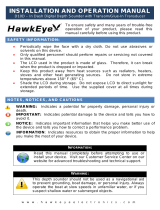
1. MOUNTING
1-7
• Air bubbles and turbulence
caused by movement of
the boat seriously degrade
the sounding capability of
the transducer. The trans-
ducer should, therefore, be
located in a position where
water flow is the smooth-
est. Noise from the propel-
lers also adversely affects
performance and the trans-
ducer should not be mount-
ed nearby. The lifting
strakes are notorious for
creating acoustic noise,
and these must be avoided
by keeping the transducer
inboard of them.
• The transducer must always remain submerged, even when the boat is rolling,
pitching or up on a plane at high speed.
• A practical choice would be somewhere between 1/3 and 1/2 of your boat's length
from the stern. For planing hulls, a practical location is generally rather far astern,
so that the transducer is always in water regardless of the planing attitude.
Installation procedure
1. With the boat hauled out of the water, mark the location chosen for mounting the
transducer on the bottom of the hull.
2. If the hull is not level within 15° in any direction, fairing blocks made out of teak
should be used between the transducer and hull, both inside and outside, to keep
the transducer face parallel with the water line. Fabricate the fairing block as
shown below and make the entire surface as smooth as possible to provide an
undisturbed flow of water around the transducer. The fairing block should be
smaller than the transducer itself to provide a channel to divert turbulent water
around the sides of the transducer rather than over its face.
3. Drill a hole just large enough to pass the threaded stuffing tube of the transducer
through the hull, making sure it is drilled vertically.
4. Apply a sufficient amount of high quality caulking compound to the top surface of
the transducer, around the threads of the stuffing tube and inside the mounting
hole (and fairing blocks if used) to ensure watertight mounting.
●
Within the wetted bottom area
●
Deadrise angle within 15°
●
Position 1/2 to 1/3 of the hull from stern.
●
15 to 30 cm off center line (inside first lifting strakes.)
DEEP V
HULL
HIGH SPEED
V HULL
Hole for stuffing tube
Saw along slope of hull.
Upper Half
Lower Half
BOW




















